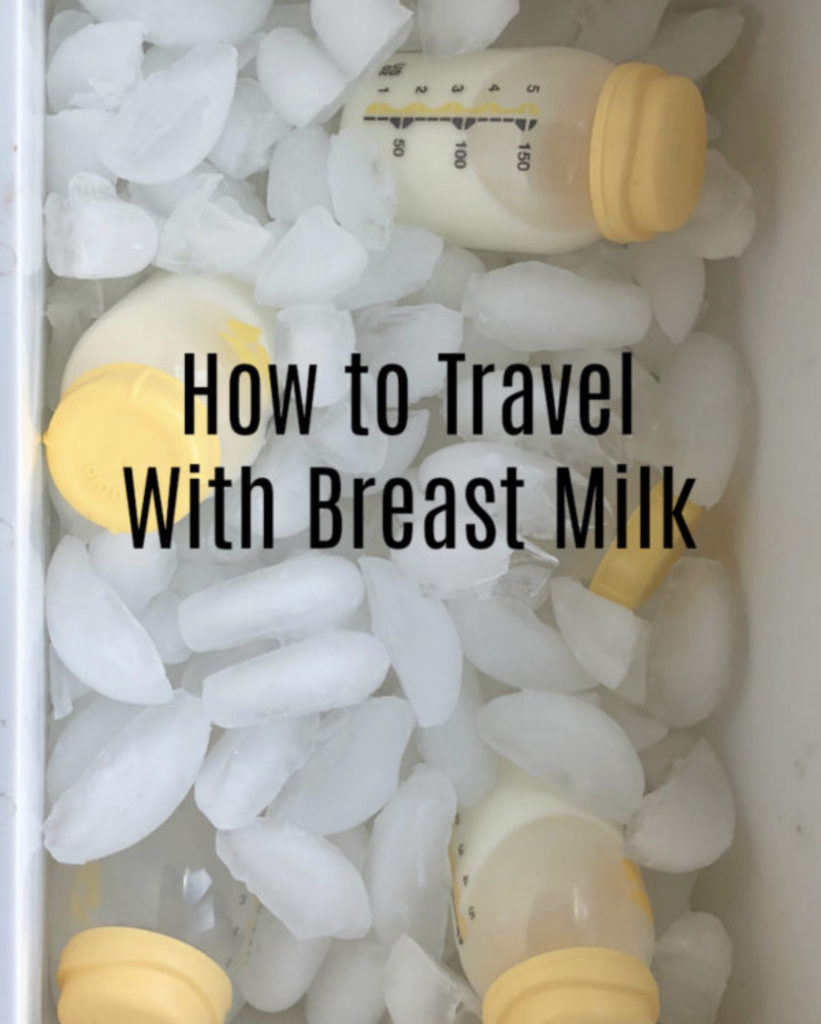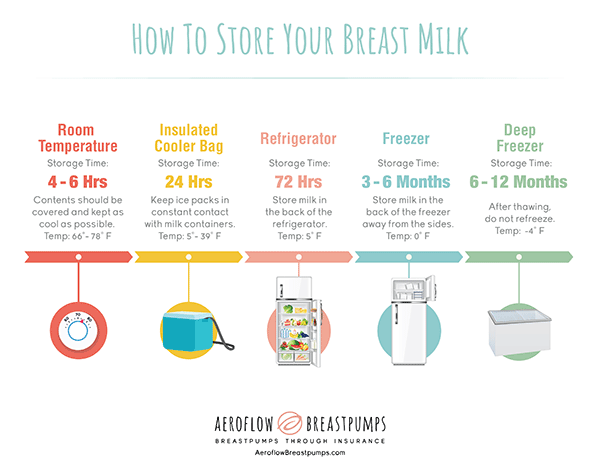
A few weekends ago, Scott and I traveled to Florida for a 4 day/3 night trip with our friends. As I have mentioned before in other posts, I am exclusively pumping. I’m not going to lie, I was worried about this trip and how pumping would go- there was a lot of planning that went into this!
Prior to the trip, I read a few online articles (like this!) about traveling with breast milk and consulted the TSA guidelines here. I also reached out to Scott’s cousin, Alexi, as she traveled quite a bit for work while she was breastfeeding her daughter. After gathering information and tips, I felt *a little* prepared, but I wanted to share what I personally learned from this experience.
I referred back to this information from Aeroflow quite a bit, so I wanted to share it here- screenshot to save!

When packing for the trip, I also had to think about everything I would need to pump, store, and transport the milk home. I also projected the number of ounces I would likely come home with- I typically pump 30-33 oz/day, so I guessed that I would be bringing home approximately 120ish oz. I packed:
- Both of my breast pumps with all accessories- tubing, flanges, etc. I actually have two different breast pumps and talk about why here. I knew that I would need the Medela Freestyle if I wanted to pump on the go, but I also wanted to bring the Medela Symphony to use in the hotel room since it works a little better for me.
- Bag for my pump and accessories
- 30 Medela milk storage bags
- 5 large ziploc bags
- 5 ice packs
- Breast pump cleaning wipes
- Yeti cooler (of course out of all the coolers to buy, Scott bought this one haha!); more affordable option here
Our flight to Florida was at 9:20 AM, so I pumped at home at 5 AM and planned to pump again after we got through security. After we checked our luggage, I was carrying this bag with the Medela Freestyle, pump accessories, pump charger, milk storage bags, ziploc bags, pump cleaning wipes, and ice packs along with my purse. Scott was carrying the empty cooler. I had no milk with me when we went through security, so there was no issue. Once we got through security, I went to the lactation room to pump before our 2.5 hour flight.
For you Nashville gals, BNA has a lactation room- nothing fancy, but at least you get a little space to yourself. It is located at the A/B terminal by Noshville. More information here.
Once I pumped, I stored the milk in these bags and then put the bags inside a ziploc bag- just in case anything spilled, I didn’t want to lose any milk! I then placed the milk in the bottom section (its insulated) of this bag along with some ice packs.
Once we landed in Florida, we went straight to the hotel and during check-in I asked if I could store breast milk in their freezer. The hotel staff was very accommodating and said that I could store as much as I needed.
Tip: I wasn’t worried that this hotel wouldn’t let me store milk, but to be on the safe side I would call prior to your stay and let the staff know that you will need to store milk. Some hotels are able to arrange for a mini freezer to be brought to your room; others will let you put the milk in their employee freezer.
Each day that we were there, I would pump every 4ish hours and at the end of the day we would bring a ziploc bag full of the milk down to the front desk and they would walk me back to their employee breakroom where I could put everything in the freezer. We did have a mini fridge in our room (no freezer), so I was able too keep the milk cold until I brought it down to the freezer.
Our flight home was going to be a little bit more tricky as our flight wasn’t until 7 PM that evening, but check-out at the hotel was 11 AM. We had plans to spend the day with our friends on a boat and then leave from there to go to the airport. I pumped in the morning at the hotel at 2 AM, 6 AM, and 10 AM. We then retrieved our frozen bags of milk during checkout and put them inside the Yeti cooler with ice packs all around. I added the liquid bags of milk that I had pumped that morning into the cooler as well. We took our luggage and met our friends for a boat day- thankfully, this was a very nice boat that had living quarters underneath. Once we got on the boat, we placed the liquid bags of milk that I had pumped that morning into the freezer (the boat had a kitchen) and I was able to pump throughout the day and place all milk in the freezer. I ended up pumping at 2 PM and again at 5 PM right before the boat docked. Both of these bags did not have time to freeze, so this was the only milk I was traveling with that wasn’t frozen (approximately 10 oz). I ended up dividing this milk into 3 storage bags of approximately 3ish ounces each- I had been told that TSA would be much nicer if liquid breast milk is around 3 ounces or less in the storage bags (versus filling them to 5 oz). For frozen milk, the amount doesn’t matter.
Once we docked, we headed to the Fort Lauderdale airport with all of our luggage. We checked our luggage and Scott was carrying-on the Yeti cooler full of frozen milk and I was carrying-on this bag with the bags of liquid milk (placed in the insulated bottom with ice packs), the Medela Freestyle, pump accessories, pump charger, and storage bags. I was planning on pumping once we got through TSA before the flight took off.
At TSA, I informed them that we were traveling with frozen breast milk in the cooler and (3) 3 oz. bags of liquid milk in the smaller bag. They advised us that everything would go through the machine, but since we did have liquids with us, they were going to have to inspect everything. They took us over to the side and they manually went through our carry-on bags. They didn’t bat an eye at the 100+ ounces of frozen milk in the cooler. According the the TSA worker, our bags would also have to be checked for explosive residue. He stated that he could not open the liquid bags of milk (not sure why, but I was a-okay with that) and they had to check for residue because some explosives can be liquid in nature. He also stated that one of us (Scott or myself) would need to have a pat down. Obviously, we were totally fine with all of that and wanted to be as compliant as possible (and nice- that goes and long way!). I volunteered Scott for the pat down (haha!) and they wiped down all our bags for explosive residue. Surprisingly, my breast pump came back as positive, which was mildly funny, so they put the pump back through the big x-ray/security machine.
Tip: Try your best to go through TSA with frozen breastmilk. They didn’t seem to have any issue with that- it is the liquid milk they are concerned with.
Going through TSA definitely took longer this time around, so if you are traveling with milk I would allot 30 extra minutes at least!
Tip: some airports have Mamava lactation pods for breastfeeding/pumping mothers. The Fort Lauderdale Airport did have them, but keep in mind you must download the Mamava app in order to unlock the pod. I was running around the airport trying to locate the pod so I could pump prior to takeoff. Once I found the pod, I quickly realized that I would need to get the app in order to even open the dang thing haha! I included more information about the Mamava pods here.
Lastly, it is possible to mail/ship breast milk, which is useful if you are on a long trip away and need to get milk home to baby. I looked into these options as I was worried about traveling home with such a large amount of milk, but ultimately I felt like it was just too expensive.
Shipping breast milk is much more expensive than flying with it. You can ship breast milk on dry ice via FedEx. Dry ice, a Styrofoam cooler, and a box for shipping can be purchased locally and possibly delivered to your hotel- search Google for a local supplier. The dry ice is so cold that it can make plastic breast milk storage bags or bottles very brittle, and they can break in shipping. It is best to seal your breast milk bottles in ziploc bags and then pad them with crumpled up newspaper inside your cooler of dry ice. You can print out a FedEx shipping label online. I have heard of people shipping breast milk on regular ice via overnight US mail. The US Postal Service does not permit dry ice in the mail. Although this is a much cheaper option, there is real risk that your milk will thaw en route. Milk Stork is another shipping option, but it comes at a hefty price- I was looking at nearly $300 to ship my milk home! I have had a few girlfriends use this company, but I just felt like it was way too expensive.
I hope this information was helpful for any of you planning on traveling with breast milk. Luckily, I had a pretty good experience with TSA- I do think being nice definitely helps haha! If I missed any important tips or if you want to share your own experience traveling with breast milk please do in the comments below! Your tips/experience could be helpful to all of us mamas!
Thank you for reading! xo- A

